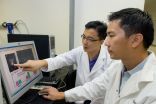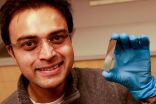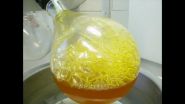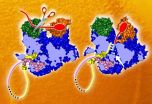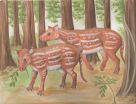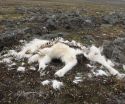NTU Singapore develops novel 2-in-1 biomarker and drug delivery system
2014-11-20
Nanyang Technological University in Singapore (NTU Singapore) has invented a unique biomarker with two exceptional functions.
First, it lights up when it detects tumour cells to allow scientists to take a better look. And it can also release anti-cancer drugs at the same time to the specific cells.
This new biomarker, which has immense potential for drug development, is made from a nanophosphor particle, ten thousand times smaller than a grain of sand.
NTU Singapore associate professors Zhang Qichun and Joachim Loo have found a way to make the nanoparticle light up ...
A path to brighter images and more efficient LCD displays
2014-11-20
SALT LAKE CITY, Nov. 20, 2014 - University of Utah engineers have developed a polarizing filter that allows in more light, leading the way for mobile device displays that last much longer on a single battery charge and cameras that can shoot in dim light.
Polarizers are indispensable in digital photography and LCD displays, but they block enormous amounts of light, wasting energy and making it more difficult to photograph in low light.
The Utah electrical and computer engineering researchers created the filter by etching a silicon wafer with nanoscale pillars and holes ...
How fallopian tubes carry eggs unidirectionally
2014-11-20
Researchers in Japan have revealed the mechanism that determines the direction of the transportation of eggs in the fallopian tube.
Fallopian tubes, or oviducts, connect the ovaries and uterus. They are also the place where the egg and sperm meet and fertilization occurs, in addition the tubes have the ability to carry the eggs/embryos to the uterus. Because of these important roles they are an absolutely essential part of the reproductive system. The luminal cells of the fallopian tubes have cilia (hair-like structures) on their surfaces, and by the ciliary movement ...
Oat oil preparation makes you feel fuller
2014-11-20
Oats contain more fat than other cereals, and oat oil has a unique composition. A new study from Lund University, Härröd Research and Swedish Oat Fiber AB, shows a special oat oil preparation can produce greater satiety.
The study followed 34 healthy individuals who were given different quantities of the oat oil preparation as part of a normal breakfast. The researchers found that levels of satiety hormones in the intestines rose more with the oat oil preparation than with the placebo 3-7 hours after the meal (by anything from a tenth to half, depending on the ...
In full view
2014-11-20
If you planned to sabotage a factory, a recon trip through the premises would probably be much more useful than just peeping in at the windows. Scientists looking to understand - and potentially thwart - the influenza virus have now gone from a similar window-based view to the full factory tour, thanks to the first complete structure of one of the flu virus' key machines. The structure, obtained by scientists at the European Molecular Biology Laboratory (EMBL) in Grenoble, France, allows researchers to finally understand how the machine works as a whole. Published today ...
Versatile bonding for lightweight components
2014-11-20
Shedding pounds is all the rage these days and the global trend toward weight reduction has even spread to the automobile industry. Cars are to get even lighter - using new materials such as ultra-high-strength steels or carbon, and carbon-fiber-reinforced plastics (CFRP). But no matter which diet regime and which lightweight components manufacturers choose, they all want the same thing: the best and longest-lasting joining method for vehicle components. Since Duroplast, which often serves as the matrix component for CFRPs, can't be welded, another joining technique is ...
Climate change will slow China's progress in reducing infectioius diseases
2014-11-20
China has made significant progress increasing access to tap water and sanitation services, and has sharply reduced the burden of waterborne and water-related infectious diseases over the past two decades. However, in a study published in the latest edition of Nature Climate Change, researchers from Emory University found that climate change will blunt China's efforts at further reducing these diseases in the decades to come.
The study found that by 2030, changes to the global climate could delay China's progress reducing diarrheal and vector-borne diseases by up to seven ...
Professional majors strengthen the mission of liberal arts colleges
2014-11-20
Faced with declining enrollment and rising costs, some small liberal arts colleges have added professional and vocational majors, a decision University of Iowa researchers say has strengthened rather than undermined the mission of the schools.
In fact, students at liberal arts colleges realized virtually the same educational gains, no matter their major, according to the UI report released earlier this month. The only differences were liberal arts major expressed a greater interest in literacy while professional majors scored higher in leadership skills.
"Essentially, ...
MSK team makes key discovery in understanding immunotherapy's successes -- and its failures
2014-11-20
A collaborative team of leaders in the field of cancer immunology from Memorial Sloan Kettering Cancer Center has made a key discovery that advances the understanding of why some patients respond to ipilimumab, an immunotherapy drug, while others do not. MSK was at the forefront of the clinical research that brought this CTLA-4 blocking antibody to melanoma patients.
A report published online first today in the New England Journal of Medicine shows that in patients who respond to ipilimumab, their cancer cells carry a high number of gene mutations--some of which make ...
Three drugs may be better than one for certain patients with advanced colorectal cancer
2014-11-20
Barcelona, Spain: Patients with a form of advanced colorectal cancer that is driven by a mutated version of the BRAF gene have limited treatment options available. However, results from a multi-centre clinical trial suggest that the cancer may respond to a combination of three targeted drugs.
Professor Josep Tabernero, head of the medical oncology department at Vall d'Hebron University Hospital and director of the Vall d'Hebron Institute of Oncology, Barcelona, Spain, will tell the 26th EORTC-NCI-AACR [1] Symposium on Molecular Targets and Cancer Therapeutics in Barcelona ...
New approach for treating ALS
2014-11-20
(PHILADELPHIA) - Amyotrophic lateral sclerosis (ALS), also known as Lou Gehrig's disease, is a neurodegenerative disease that primarily kills motor neurons, leading to paralysis and death 2 to 5 years from diagnosis. Currently ALS has no cure. Despite promising early-stage research, the majority of drugs in development for ALS have failed. Now researchers have uncovered a possible explanation. In a study published November 20th in the Annals of Clinical and Translational Neurology, researchers show that the brain's machinery for pumping out toxins is ratcheted up in ALS ...
Serotonin's early role in the assembly of brain circuits
2014-11-20
A lot of research has shown that poor regulation of the serotonin system, caused by certain genetic variations, can increase the risk of developing psychiatric illnesses such as autism, depression, or anxiety disorders. Furthermore, genetic variations in the components of the serotonin system can interact with stress experienced during the foetal stages and/or early childhood, which can also increase the risk of developing psychiatric problems later on.
In order to better understand serotonin's influence in the developing brain, Alexandre Dayer's team in the Psychiatry ...
Out of India
2014-11-20
Working at the edge of a coal mine in India, a team of Johns Hopkins researchers and colleagues have filled in a major gap in science's understanding of the evolution of a group of animals that includes horses and rhinos. That group likely originated on the subcontinent when it was still an island headed swiftly for collision with Asia, the researchers report Nov. 20 in the online journal Nature Communications.
Modern horses, rhinos and tapirs belong to a biological group, or order, called Perissodactyla. Also known as "odd-toed ungulates," animals in the order have, ...
Permafrost soil: Possible source of abrupt rise in greenhouse gases at end of last Ice Age
2014-11-20
Bremerhaven/Germany, 20 November 2014. Scientists from the Alfred Wegener Institute, Helmholtz Centre for Polar and Marine Research (AWI) have identified a possible source of carbon dioxide (CO2) and other greenhouse gases that were abruptly released to the atmosphere in large quantities around 14,600 years ago. According to this new interpretation, the CO2 - released during the onset of the Bølling/Allerød warm period - presumably had their origin in thawing Arctic permafrost soil and amplified the initial warming through positive feedback. The study now appears ...
Extreme weather in the Arctic problematic for people, wildlife
2014-11-20
The residents of Longyearbyen, the largest town on the Norwegian arctic island archipelago of Svalbard, remember it as the week that the weather gods caused trouble.
Temperatures were ridiculously warm - and reached a maximum of nearly +8 degrees C in one location at a time when mean temperatures are normally -15 degrees C. It rained in record amounts.
Snow packs became so saturated that slushy snow avalanches from the mountains surrounding Longyearbyen covered roads and took out a major pedestrian bridge.
Snowy streets and the tundra were transformed into icy, ...
New computer model predicts gut metabolites to better understand gastrointestinal disease
2014-11-20
MEDFORD/SOMERVILLE, Mass-- Tufts University School of Engineering researchers and collaborators from Texas A&M University have published the first research to use computational modeling to predict and identify the metabolic products of gastrointestinal (GI) tract microorganisms. Understanding these metabolic products, or metabolites, could influence how clinicians diagnose and treat GI diseases, as well as many other metabolic and neurological diseases increasingly associated with compromised GI function. The research appears in the November 20 edition of Nature Communications ...
A new tool for identifying onset of local influenza outbreaks
2014-11-20
AMHERST, Mass. -- Predicting the beginning of influenza outbreaks is notoriously difficult, and can affect prevention and control efforts. Now, just in time for flu season, biostatistician Nicholas Reich of the University of Massachusetts Amherst and colleagues at Johns Hopkins have devised a simple yet accurate method for hospitals and public health departments to determine the onset of elevated influenza activity at the community level.
Hospital epidemiologists and others responsible for public health decisions do not declare the start of flu season lightly, Reich ...
Unravelling the mystery of gamma-ray bursts
2014-11-20
A team of scientists hope to trace the origins of gamma-ray bursts with the aid of giant space 'microphones'.
Researchers at Cardiff University are trying to work out the possible sounds scientists might expect to hear when the ultra-sensitive LIGO and Virgo detectors are switched on in 2015.
It's hoped the kilometre-scale microphones will detect gravitational waves created by black holes, and shed light on the origins of the Universe.
Researchers Dr Francesco Pannarale and Dr Frank Ohme, in Cardiff University's School of Physics and Astronomy, are exploring the potential ...
Fat a culprit in fibrotic lung damage
2014-11-20
(PHILADELPHIA) - Pulmonary fibrosis has no cure. It's caused by scarring that seems to feed on itself, with the tougher, less elastic tissue replacing the ever moving and stretching lung, making it increasingly difficult for patients to breathe. Researchers debate whether the lung tissue is directly damaged, or whether immune cells initiate the scarring process - an important distinction when trying to find new ways to battle the disease. Now research shows that both processes may be important, and suggest a new direction for developing novel therapies. The work will publish ...
Job authority increases depression symptoms in women, decreases them in men
2014-11-20
WASHINGTON, DC, November 17, 2014 -- A new study finds that having job authority increases symptoms of depression among women, but decreases them among men.
"Women with job authority -- the ability to hire, fire, and influence pay -- have significantly more symptoms of depression than women without this power," said Tetyana Pudrovska, an assistant professor in the Department of Sociology at the University of Texas at Austin and the lead author of the study. "In contrast, men with job authority have fewer symptoms of depression than men without such power."
Titled, ...
Heterosexuals have egalitarian views on legal benefits for same-sex couples, not on PDA
2014-11-20
WASHINGTON, DC, November 18, 2014 -- A new study indicates that heterosexuals have predominately egalitarian views on legal benefits for -- but not public displays of affection (PDA) by -- same-sex couples.
"We found that, for the most part, heterosexuals are equally as supportive of legal benefits for same-sex couples as they are for heterosexual couples, but are much less supportive of public displays of affection for same-sex couples than they are for heterosexuals," said Long Doan, a PhD candidate in the Department of Sociology at Indiana University and the lead author ...
Only half of patients take their medications as prescribed
2014-11-20
The cost of patients not taking their medications as prescribed can be substantial in terms of their health. Although a large amount of research evidence has tried to address this problem, there are no well-established approaches to help them, according to a new systematic review published in the Cochrane Library. The authors of the review examined data from 182 trials testing different approaches to increasing medication adherence and patient health. Even though the review included a significant number of the best studies to date, in most cases, trials had important problems ...
For women, job authority adds to depression symptoms
2014-11-20
AUSTIN, Texas -- Job authority increases symptoms of depression among women, but decreases them among men, according to a new study from University of Texas at Austin sociologist Tetyana Pudrovska.
"Women with job authority -- the ability to hire, fire, and influence pay -- have significantly more symptoms of depression than women without this power," said Pudrovska, the lead author of the study. "In contrast, men with job authority have fewer symptoms of depression than men without such power."
The study, "Gender, Job Authority, and Depression," published in the December ...
Real-time genome sequencing helps control hospital outbreak
2014-11-20
Pioneering use of whole genome sequencing in real time to help control a hospital outbreak is reported in an article published in the open access journal Genome Medicine. The research corroborates the use of the technique as a rapid and cost-effective way of tracking and controlling the spread of drug-resistant hospital pathogens.
Acinetobacter baumannii is a multi-drug resistant pathogen found in hospitals across the globe and emerged as a significant threat to casualties in the Iraq and Afghanistan wars. It affects severely ill patients, particularly trauma and burns ...
Sun's rotating 'magnet' pulls lightning towards UK
2014-11-20
The Sun may be playing a part in the generation of lightning strikes on Earth by temporarily 'bending' the Earth's magnetic field and allowing a shower of energetic particles to enter the upper atmosphere.
This is according to researchers at the University of Reading who have found that over a five year period the UK experienced around 50% more lightning strikes when the Earth's magnetic field was skewed by the Sun's own magnetic field.
The Earth's magnetic field usually functions as an in-built force-field to shield against a bombardment of particles from space, known ...
[1] ... [3063]
[3064]
[3065]
[3066]
[3067]
[3068]
[3069]
[3070]
3071
[3072]
[3073]
[3074]
[3075]
[3076]
[3077]
[3078]
[3079]
... [8709]
Press-News.org - Free Press Release Distribution service.
